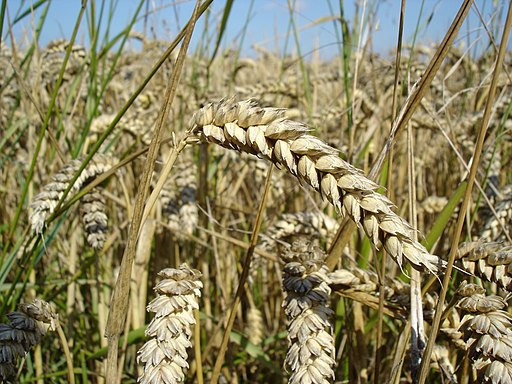http://profcj.org/ep-0016/
http://profcj.org/ep-0017/
http://profcj.org/ep-0018/
http://profcj.org/ep-0019/
Tuesday, January 31, 2017
Friday, January 27, 2017
Intruders
https://vimeo.com/147392797
In the aftermath of a deadly haunting in a small suburban home, a sinister omnipresent entity proceeds to cause havoc in the private lives of a young boy, an unsuspecting teen, and an absent minded inspector.
Website - santiagomenghini.com/intruders/
Intruders: Case Study - thefilmeffect.com/intruders-case-study/
Facebook - facebook.com/intrudersthemovie
"5:45 a.m." - Based on the short comic of by Al Columbia (orangesunshinehouse.com/)
"Jacov" - Based on the short comic by Uno Moralez (unomoralez.com/)
Website - santiagomenghini.com/intruders/
Intruders: Case Study - thefilmeffect.com/intruders-case-study/
Facebook - facebook.com/intrudersthemovie
"5:45 a.m." - Based on the short comic of by Al Columbia (orangesunshinehouse.com/)
"Jacov" - Based on the short comic by Uno Moralez (unomoralez.com/)
Thursday, January 26, 2017
The Dangerous History Podcast Ep. 0031: Uncle Sam vs. Democracy Part 1: Operation Ajax / Ep. 0032: Uncle Sam vs Democracy, Part 2: Operation PB Success
Ep. 0031: Uncle Sam vs. Democracy Part 1: Operation Ajax
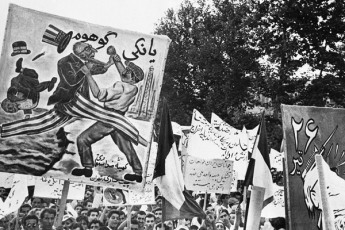
Audio Player
Podcast: Play in new window | Download
In this episode and the next, we’re going to look at two instances in the early Cold War of American-sponsored and -instigated overthrows of democratically elected governments, and their replacement by unpopular, USA-backed dictatorships. Of course, I’m talking about Iran and Guatemala in the early-1950s. This episode will set the context and cover Iran. Next time we’ll cover Guatemala and consequences of these sorts of operations.
Join Prof CJ as he discusses:
- A quick sketch of the Dulles Brothers (John Foster & Allen) who played such key roles in these sorts of operations in the 1950s
- A look at the historical context (ie, early Cold War)
- A sketch of Iranian PM Mohammed Mossadegh, and why the Dulles Bros (and the corporate interests they served) wanted him overthrown
- How the CIA overthrew Mossadegh and replaced him with Shah Reza Pahlavi
- The aftermath of this operation and its legacy, which is still being felt today
Ep. 0032: Uncle Sam vs Democracy, Part 2: Operation PB Success
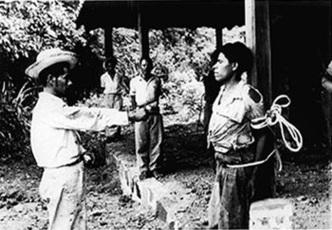
Audio Player
Podcast: Play in new window | Download
Encouraged by their success against Iran’s democratic government (covered in last episode), the Dulles Brothers’ next move was against the small central American country of Guatemala, where a left-of-center government appeared to be threatening the interests of the United Fruit Company.
Join Prof CJ as he discusses:
- The immediate backstory on Guatemala, including the dominance of American corporations over the country, its democratic revolution in 1944 and the election of Jacobo Arbenz Guzman to the presidency in 1951
- The Arbenz government’s Decree 900, aimed at redistributing unused land to poor peasants
- The CIA’s Operation PB Success, a largely psychological campaign that succeeded in overthrowing Arbenz in June 1954
- How the CIA itself, after ousting Arbenz, failed to find any real evidence that Arbenz was in league with the Soviets
- The brutal aftermath of this coup, which caused suffering and oppression in Guatemala for decades and killed over 200,000 people
- A brief thought experiment of how Americans might respond if they were put in an analogous situation
- Some discussion of the concept known as “blowback”
The Dangerous History Podcast Ep. 0023: How the United States Acquired Florida (the First Seminole War) / Ep. 0024: The Second Seminole War
Ep. 0023: How the United States Acquired Florida (the First Seminole War)
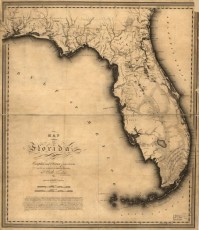
Audio Player
Podcast: Play in new window | Download
This is the little-known story of how Florida became a part of Team America. (Spoiler: It wasn’t totally voluntary…)
Join Prof CJ as he discusses:
- The background to the war: what was going on in Florida leading up to the war, & who the Seminoles were, including the so-called ‘Black Seminoles’
- Why the United States coveted Florida almost from day one of getting its independence
- The destruction of the so-called “Negro Fort” by American forces in 1816
- The immediate issues that led to fighting beginning in late 1817, culminating in Andrew Jackson’s invasion of West Florida in 1818
- How Jackson exceeded his orders (which just allowed him to retaliate against hostile Indians), and went so far as to seize Spanish installations and execute two Brits who were found in the area
- Secretary of State John Quincy Adams’ successful negotiation of a treaty in 1819 formally transferring Florida (East and West) to the US without provoking war or major retaliations from either Spain or Britain
- How, even after the American takeover of Florida, Americans continued to see the Seminoles as a major problem, one that would be ‘dealt with’ beginning in the 1830s with the Second Seminole, which was much larger and costlier than the First, and which we’ll cover next episode
- The troubling precedent set for the American Republic by Jackson’s actions in this undeclared war
Ep. 0024: The Second Seminole War
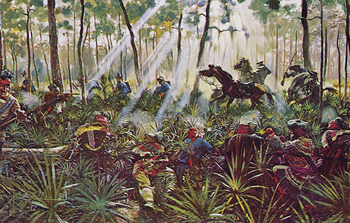
Audio Player
Podcast: Play in new window | Download
Last time, we covered the First Seminole War; this time, we get to the nastier sequel.
The Second Seminole war was the US government’s longest and most expensive Indian War. It also had many parallels to later campaigns in harsh environments against determined guerrilla fighters, and many lessons which, unfortunately, were not learned, as the nation did its best to consign the conflict to the ‘memory hole’ soon after its end. Long before the Philippines War, and even longer before Vietnam, there was this brutal war…
Join Prof CJ as he discusses:
- The 1823 Treaty of Moultrie Creek, which tried to confine the Seminoles to a reservation in central Florida, requiring most of them to relocate, cutting off their access to the coasts, denying their freedom of movement, and requiring them to assist in the capture and return of escaped slaves
- The election of Andrew Jackson as president in 1828, which would have disastrous consequences for Southeastern Indians, including the Seminole
- The Indian Removal Act and subsequent attempts to bribe or dupe the Seminoles into relocating out West
- The rise of Osceola
- The beginning of violence in 1835 with the so-called ‘Dade Massacre’ and assassination of the US Indian Agent Wiley Thompson
- How US General Thomas Jesup captured Osceola by betraying a flag of truce, something even most white Americans found dishonorable
- Osceola’s captivity and death from illness within a few months
- The brutal Battle of Lake Okeechobee on Christmas Day, 1837
- Continued Seminole guerrilla operations and American countermeasures, which sought to grind them down
- The cessation of fighting in 1842, by which time the Seminole population of Florida had been reduced by approximately 94% in 20 years due to death and deportation
- A brief mention of the much smaller Third Seminole War (1855-58)
- Some concluding thoughts about this war from historians who have written about it extensively, and from Prof CJ
Wednesday, January 25, 2017
Monday, January 23, 2017
The Dangerous History Podcast Ep. 0087: Grain and the State
http://profcj.org/grain-and-the-state/
Copyright © 2014. All rights reserved.
Ep. 0087: Grain and the State
Audio Player
Podcast: Play in new window | Download
Join CJ as he discusses:
- How people lived in the Paleolithic Era, which actually encompasses the vast majority of human existence
- The Neolithic Revolution and the coming of agriculture
- The domestication of grains and their rise to dominate global food production
- The rise of “civilization,” including its downsides
- The characteristics of grains which make them the preferred food crops of states
- Alternatives to sedentary, fixed-field, grain-dominated agriculture, which states tend to discourage
- A few thoughts and observations about grains and states in the modern world
External Links
- A lecture by James C. Scott entitled, “How Grains Domesticated Us”, which is the one from which I played an excerpt and to which I referred several times in the show
- Another great James C. Scott lecture, “The Art of Not Being Governed” which discusses a lot of similar and related topics (I also highly recommend Scott’s book The Art of Not Being Governed — see below)
- The Dangerous History Podcast is covered by a BipCot No Gov license; learn more at BipCot.org
Prof CJ’s Picks (buy anything from Amazon via these affiliate links to help support the show at no additional cost to you)
Wheat photo attribution: By User:Bluemoose (Own work) [GFDL (http://www.gnu.org/copyleft/fdl.html), CC-BY-SA-3.0 (http://creativecommons.org/licenses/by-sa/3.0/) or CC BY-SA 2.5-2.0-1.0 (http://creativecommons.org/licenses/by-sa/2.5-2.0-1.0)], via Wikimedia Commons
Copyright © 2014. All rights reserved.
Thursday, January 19, 2017
Metroid - Rogue Dawn - Unofficial NES prequel to the original Metroid game released!
http://www.indieretronews.com/2017/01/metroid-rogue-dawn-unofficial-nes.html
http://www.romhacking.net/hacks/3280/ (Patch)
http://projects.sappharad.com/tools/multipatch.html (MultiPatch patching tool OSX)
https://www.emuparadise.me/Nintendo_Entertainment_System_ROMs/Metroid_(USA)/56279 (Original ROM)
http://www.bannister.org/software/nestopia.htm (Nintendo NES Emulator OSX)
http://www.romhacking.net/hacks/3280/ (Patch)
http://projects.sappharad.com/tools/multipatch.html (MultiPatch patching tool OSX)
https://www.emuparadise.me/Nintendo_Entertainment_System_ROMs/Metroid_(USA)/56279 (Original ROM)
http://www.bannister.org/software/nestopia.htm (Nintendo NES Emulator OSX)
Monday, January 16, 2017
Saturday, January 7, 2017
Subscribe to:
Posts (Atom)
